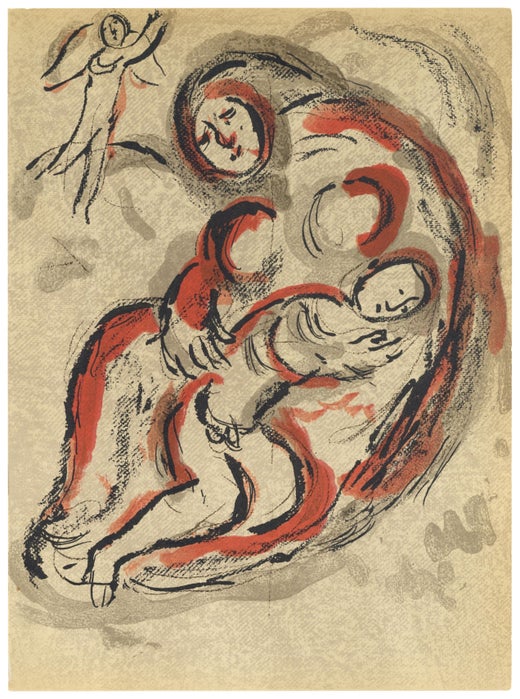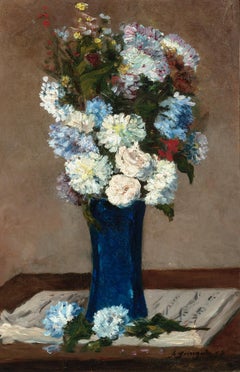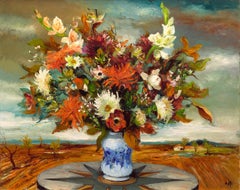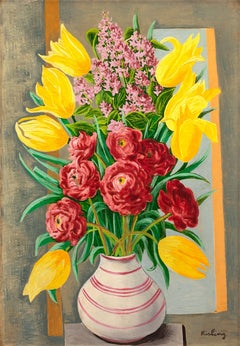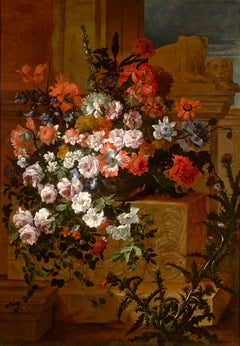Marc ChagallLes Fleurs Rouges By Marc Chagall1950
1950
About the Item
- Creator:Marc Chagall (1887 - 1985, French)
- Creation Year:1950
- Dimensions:Height: 42.88 in (108.92 cm)Width: 37.25 in (94.62 cm)Depth: 2.13 in (5.42 cm)
- Medium:
- Movement & Style:
- Period:
- Condition:
- Gallery Location:New Orleans, LA
- Reference Number:Seller: 31-80891stDibs: LU18613415052
Marc Chagall
Described by art critic Robert Hughes as "the quintessential Jewish artist of the twentieth century," the Russian-French modernist Marc Chagall worked in nearly every artistic medium. Influenced by Symbolism, Fauvism, Cubism and Surrealism, he developed his own distinctive style, combining avant-garde techniques and motifs with elements drawn from Eastern European Jewish folk art.
Born Moishe Segal in 1887, in Belarus (then part of the Russian empire), Chagall is often celebrated for his figurative paintings, but he also produced stained-glass windows for the cathedrals of Reims and Metz, in France; for the United Nations, in New York; and for the Hadassah Hospital in Jerusalem, as well as book illustrations, stage sets, ceramics, tapestries and fine-art prints. Characterized by a bold color palette and whimsical imagery, his works are often narrative, depicting small-village scenes and quotidian moments of peasant life, as in his late painting The Flight into Egypt from 1980.
Before World War I, Chagall traveled between St. Petersburg, Paris and Berlin. When the conflict broke out, he returned to Soviet-occupied Belarus, where he founded the Vitebsk Arts College before leaving again for Paris in 1922. He fled to the United States during World War II but in 1947 returned to France, where he spent the rest of his life. His peripatetic career left its mark on his style, which was distinctly international, incorporating elements from each of the cultures he experienced.
Marc Chagall remains one of the past century’s most respected talents — find his art on 1stDibs.
You May Also Like
1920s Fauvist Still-life Drawings and Watercolors
Paper, Watercolor, Gouache
1920s Fauvist Still-life Drawings and Watercolors
Paper, Gouache
1920s Fauvist Still-life Drawings and Watercolors
Paper, Watercolor, Gouache
Mid-20th Century Pointillist Still-life Paintings
Gouache
1990s Realist Still-life Paintings
Paper, Pastel, Watercolor
1990s Realist Still-life Paintings
Paper, Pastel, Watercolor
1980s Realist Still-life Paintings
Paper, Pastel, Watercolor
1970s Modern Still-life Drawings and Watercolors
Paper, Gouache
Late 20th Century Still-life Paintings
Watercolor, Gouache, Handmade Paper, Silk
1970s Still-life Paintings
Paper, Gouache
More From This Seller
View All19th Century Post-Impressionist Still-life Paintings
Canvas, Oil
20th Century Post-Impressionist Still-life Paintings
Canvas, Oil
20th Century Modern Still-life Paintings
Canvas, Oil
17th Century Old Masters Still-life Paintings
Canvas, Oil
Mid-20th Century Modern Still-life Paintings
Oil
20th Century Modern Still-life Paintings
Oil
Recently Viewed
View AllRead More
Paul Revere Crafted This Silver Coffee Pot 250 Years Ago
Perhaps best known as a Revolutionary War hero, Revere was also an accomplished silversmith, and this pot is now available on 1stDibs.
Degas Portrayed These Exuberant Ukrainian Dancers with ‘Orgies of Color’
Discovered in Parisian cabarets, the performers reenergized the artist’s practice.
